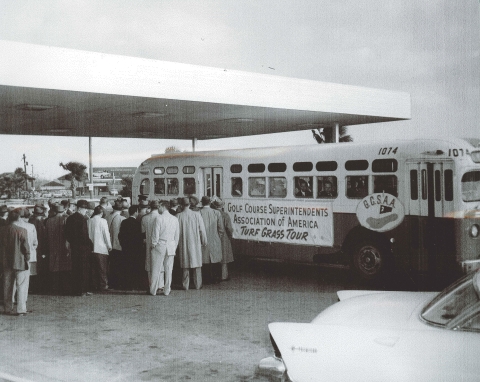Grass Keeps Getting Greener for the Golf Industry Show

At the 1928 conference of the National Association of Greenkeepers of America (now known as the Golf Course Superintendents Association of America), 350 participants gathered at the Hotel Fort Shelby in Detroit to see the latest innovations in golf course maintenance equipment and technology from 27 exhibitors.
Fred A. Burkhardt from Cleveland, Ohio, spearheaded efforts to launch the National Greenkeepers Golf Show, with the goal of offering collaboration opportunities for golf course managers to exchange ideas and strengthen
peer-to-peer relationships. And the audience responded – floor space and attendance increased each year up until 1932.
During the next two decades, the conference and show faced difficulty during the Great Depression, then came to a halt in 1943 during the war. But in the years after the war, the show grew significantly, drawing 1,700 attendees in 1961. That year, it was renamed the International Golf Course Conference and Show, and by 1966, it filled 20,000 square feet.
By 1980, attendance had topped 7,000, and in 1984 the show was once again renamed as the International Golf Course Conference and Show.
In 2005, the show once again received a name change to reflect a collaboration with allied associations and the objective to provide networking and hands-on access to golf course and facility management
solutions for all areas of a golf course facility. Today, the Golf Industry Show is presented by GCSAA and the National Golf Course Owners Association (NGCOA), along with supporting organizations: the Golf Course
Builders Association of America, the American Society of Golf Course Architects, United States Golf Association, and the National Golf Foundation.
Also that year, the show faced a huge and unexpected challenge. It was scheduled to be held in New Orleans only seven months after Hurricane Katrina hit. The convention center was unable to hold shows at that point,
so a whole new plan had to be developed and details had to be well-communicated to exhibitors and attendees.
“We reached out to Houston and asked if they could help us out,” said trade show manager Shelly Urish. “They said yes, so we started changing the game plan. Not too far into planning, we found out there was a
conflicting show in the same building that we were not comfortable with. So we then switched the show to Atlanta within a few months prior to our event.”
Now, Urish says “when someone asks if we can do something new for next year’s show, we always say ‘Well, if we can switch venues four months out … two times … we can surely figure it out in 12 months!’ ”
That proved true again for the show this past February, after being denied the option of having a equipment test drive demo area behind the San Diego Convention Center. Instead, a 15,000-square-foot green space was
constructed on the show floor, complete with 150 tons of sand. All of the sand and sod was then donated to golf courses in the San Diego area after the show.
Today’s event now draws not only golf course superintendents, but also owners and operators, general managers, and CEOs, as well as course architects and builders. Exhibits and sessions cover all aspects of golf
course management including environmental, business, communications, and more, to help everyone do their jobs better, faster and more efficiently.
“It’s great that we have two presenting partners and four participating partners who all come together to host one show of all of our memberships at the same time,” Urish said. “This welcomes a wealth of networking
opportunities across different golf courses, different job titles, different types of golf facilities, etc. for the attendees and exhibitors. It makes sense for attendees to come to one show where they have all of
the appropriate buying decision makers at the same place.”
At this year’s show all the numbers were up, with 550 exhibitors filling 250,000 net square feet of space, and total attendance of 12,600. Two exhibitors remain that have been involved since the very first show: Toro
and Jacobsen.
Urish attributes the show’s success to the passion and pride that attendees have for the jobs they do, along with the educational and networking opportunities. “It’s common throughout all of the supporting
organizations of the Golf Industry Show to find an attendee base that leans on each other to troubleshoot problems and helps each other as much as they can.”


Add new comment